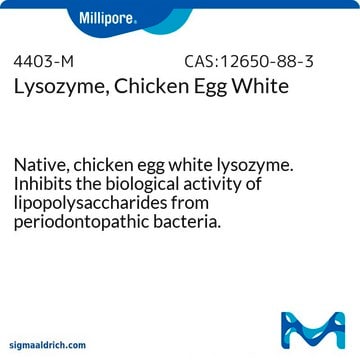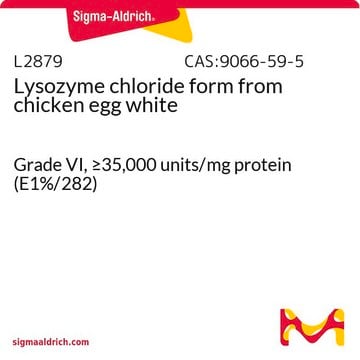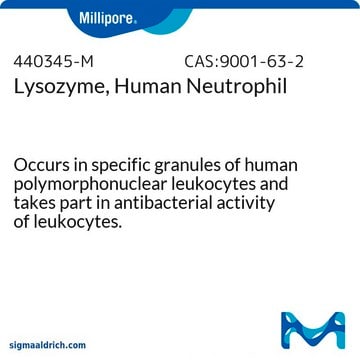10837059001
Roche
Lysozyme
from hen egg white
Synonyme(s) :
Mucopeptide N-acetylmuramoyl-hydrolase, Muramidase, lysozyme
About This Item
Produits recommandés
Source biologique
chicken egg white
Niveau de qualité
Pureté
≥95%
Forme
solid
Activité spécifique
>23000 U/mg (Shugar units)
Poids mol.
14.4 kDa
Conditionnement
pkg of 10 g
Fabricant/nom de marque
Roche
pH optimal
6.0-7.0
Absorption
3.9 at 280 nm (10 mg enzyme/ml)
Description générale
Application
- Cell wall degradation
- Preparation of protoplasts
- Bacteriolysis
- Pharmacology (anti-inflammatory effect on mucous membrane; healing of tissue; protection against bleeding; normalization of mucus secretion; dissolution of pyrogens; potentiation of antibiotics)
- Food and drinks (flavor enhancer)
- Sample preparation prior to isolation of nucleic acids
Actions biochimiques/physiologiques
Définition de l'unité
Notes préparatoires
Storage conditions (working solution): -15 to -25 °C
Aqueous solutions of the hydrochloride (2 mg/ml dist. water) can be stored for several days at 2 to 8° C or at -15 to -25° C for several weeks.
Reconstitution
Stockage et stabilité
Autres remarques
Code de la classe de stockage
11 - Combustible Solids
Classe de danger pour l'eau (WGK)
WGK 2
Point d'éclair (°F)
does not flash
Point d'éclair (°C)
does not flash
Certificats d'analyse (COA)
Recherchez un Certificats d'analyse (COA) en saisissant le numéro de lot du produit. Les numéros de lot figurent sur l'étiquette du produit après les mots "Lot" ou "Batch".
Déjà en possession de ce produit ?
Retrouvez la documentation relative aux produits que vous avez récemment achetés dans la Bibliothèque de documents.
Les clients ont également consulté
Notre équipe de scientifiques dispose d'une expérience dans tous les secteurs de la recherche, notamment en sciences de la vie, science des matériaux, synthèse chimique, chromatographie, analyse et dans de nombreux autres domaines..
Contacter notre Service technique







